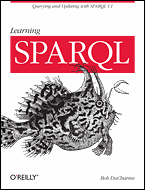 I really like an instructional book that begins with “Chapter2 provides some background on RDF, the semantic web, and where SPARQL fits in, but before going into that, let’s start with a bit of hands-on experience writing and running SPARQL queries to keep the background part from looking too theoretical.” Great decision – a great start. I appreciate this approach to learning by doing and Learning SPARQL by Bob Ducharme adopts this general approach through this volume.
I really like an instructional book that begins with “Chapter2 provides some background on RDF, the semantic web, and where SPARQL fits in, but before going into that, let’s start with a bit of hands-on experience writing and running SPARQL queries to keep the background part from looking too theoretical.” Great decision – a great start. I appreciate this approach to learning by doing and Learning SPARQL by Bob Ducharme adopts this general approach through this volume.
At the outset, I will admit that what I know about SPARQL is that it vaguely resembles SQL and allows one to query RDF and plunge into the wonderful world of linked data. At our Summer School a few weeks back we had a great introduction to linked data by Owen Conlan and Alex O’Connor that had us playing with SPARQL through the snorql web interface to dbPedia. Fun and no surprise this same heads first example shows up in the first chapter.
Chapter 2 does indeed delve into a more theoretical discussion of RDF, the semantic web and the glorious promise of linked data. The discussion is thorough and well presented and a superb introduction to basic principles extending into an advanced understanding. It provides a clear and thorough presentation of necessary concepts and provides all the basics to understand why and to approach SPARQL.
Subsequent chapters work deeper into the mechanics of SPARQL using extensive samples and also addressing potential pitfalls. The sense is that you are working along with a subject matter expert that will let you play and do it yourself, make mistakes and then work with you to work through them.
The reality is SPARQL of course if not for everyone and increasingly GUI web services provide much of the mechanics and the backend heavy lifting allowing most casual users do not need to hand code queries. However, knowledge of the capabilities of the language and some of the limitations are of great value to novices in imagining their research questions and appreciating the bounds of what questions the data may be capable of answering.
This volume is not intended for the faint-hearted, however. A casual user of Wikipedia with no programming experience may find a challenge in appreciating data structure and architecture and the rudiments of a SQL like a query language. Those working with XML and XPath and comfortable in a data architecture environment will be extremely well served by this volume as it comprehensively leads one through the why and wherefore of SPARQL and provides a thorough grounding in the vocabulary and practice of employing SPARQL to start to benefit from the growing world of Linked Data.

